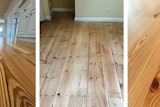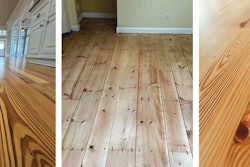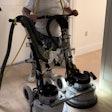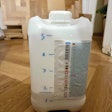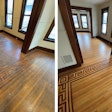
I started in the hardwood flooring trade back in 1999 at the tender age of 20. Now that it’s 2025, that puts me at what, 26 years of wood flooring experience? Over that time, I’ve gained a lot of insight from doing things that worked and, admittedly, a few things that didn’t.
One might think that once you learn how to install, sand and finish hardwood floors, it becomes routine. Well, my years of experience have taught me that it’s anything but routine. There are countless variables to account for. Sure, you could do everything the exact same way every time, but in the real world, Murphy’s Law has a funny way of showing up, making something go sideways and robbing you of a good night’s sleep.
Back in 2012, I wrote about one of those sideways moments involving something called tannin pull. (You can read about that dilemma here.) Well, I thought it would be a good idea to revisit the problem of tannin pull and share what I’ve learned about avoiding it since then.
 Tannin pull—noticeable as what looks like darker stop marks on this floor—can be avoided with the right products and precautions.
Tannin pull—noticeable as what looks like darker stop marks on this floor—can be avoided with the right products and precautions.
What tannin pull is
For those newer to the trade, let me explain what tannin pull is. Tannin pull occurs when wood tannins bleed through the finish, causing dark discolorations. It’s still a potential issue in hardwood flooring today, though modern finishes and improved application techniques have greatly reduced its occurrence.
Certain woods, like white oak and Brazilian cherry, have higher tannin content, making them more prone to tannin pull compared with woods like maple, which has very little tannin. Water-based finishes are the most susceptible to tannin pull because the water activates the tannins, drawing them to the surface. In contrast, tannin pull is almost unheard of with oil-based finishes.
Tannin pull typically appears as dark spots in the wood, often near end walls or wherever the finish pools slightly thicker, like where you set your applicator down and it deposits just a bit more finish than the middle of your pass.
I’ve also encountered tannin staining when water-popping a floor, especially on white oak. If water is allowed to pool and sit, you might notice a dark ring outlining the puddle’s shape.
How I avoid tannin pull now
Thankfully, it’s been years since I’ve seen tannin pull on my jobs, and I credit this to two factors.
First, modern water-based finishes have advanced significantly. Many now include additives specifically designed to prevent tannin pull, making it a rare occurrence.
The second factor is improved finish application techniques. Let’s go through some of the essential steps when it comes to application:
A clean floor is crucial. The fine dust left after sanding can activate tannins when exposed to even a tiny bit of water. After sanding and vacuuming, I recommend running a Tampico brush over the floor and performing a dry tack with a microfiber mop to ensure it’s spotless.
Using a high-quality finish is also essential. Yes, they cost more, but they perform better in the long term and save you money by avoiding costly issues. I’ve tested many finishes over the years and learned that not all water-based finishes are created equal. For instance, a 1K finish won’t perform as well as a 2K finish. I find the top-tier 2K finishes from major manufacturers such as Berger-Seidle’s Ceramic Star, Loba’s Supra AT, Bona’s Traffic HD and Arboritec’s Avenue are all comparable in performance. While they each have minor nuances, the decision often comes down to which company you prefer to work with. (But I digress—that’s a topic for another article!)
 Consistency in finish application is critical when avoiding tannin pull on a floor such as this white oak.
Consistency in finish application is critical when avoiding tannin pull on a floor such as this white oak.
A lesser-known technique
There’s one lesser-known application method that works exceptionally well: troweling.
 Troweling is a lesser-known finish application method in the United States, but it’s a good way to avoid tannin pull.
Troweling is a lesser-known finish application method in the United States, but it’s a good way to avoid tannin pull.
Thanks to advancements in coatings and better application techniques, worrying about tannin pull has become a thing of the past for me—just a distant memory I’m reminded of when I stumble across that old magazine article.










